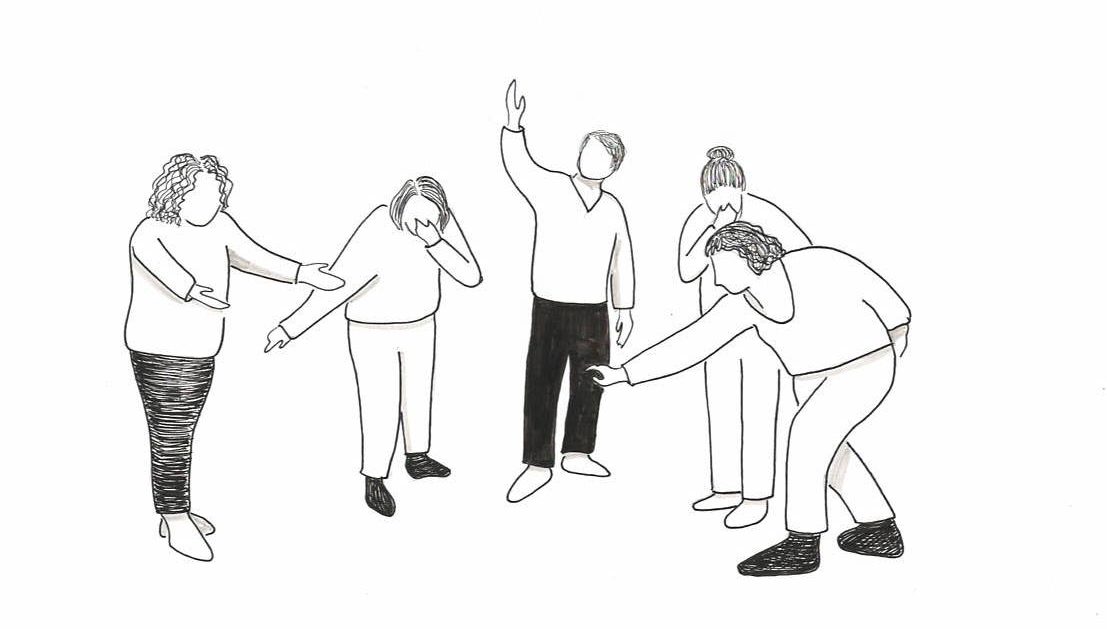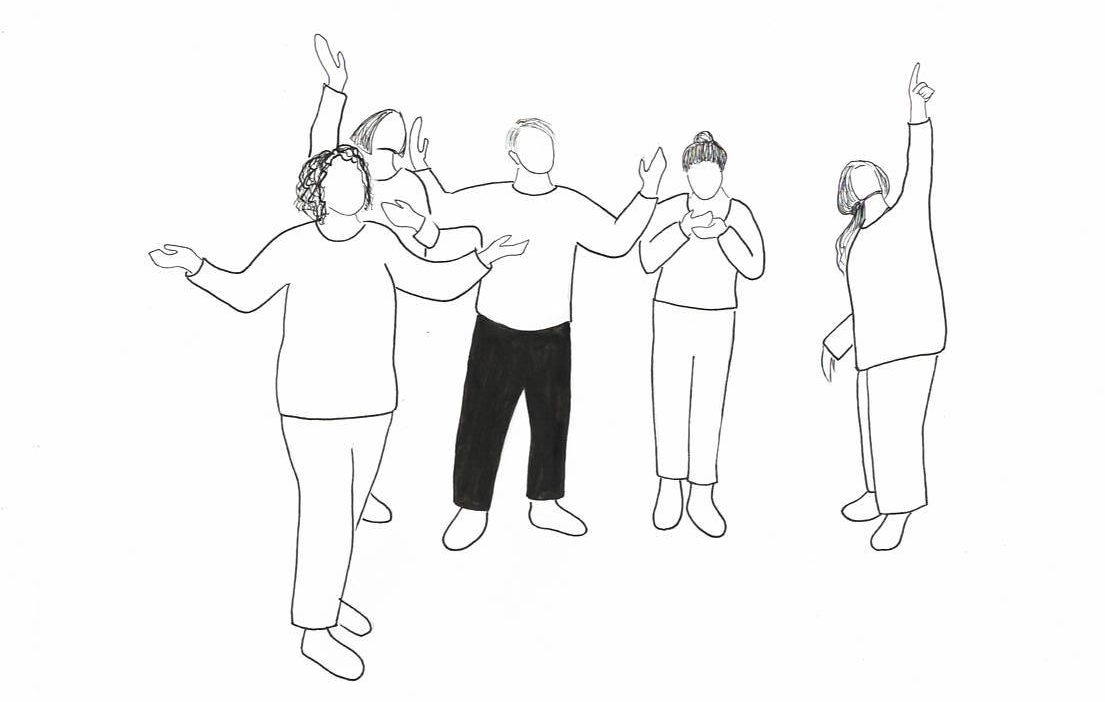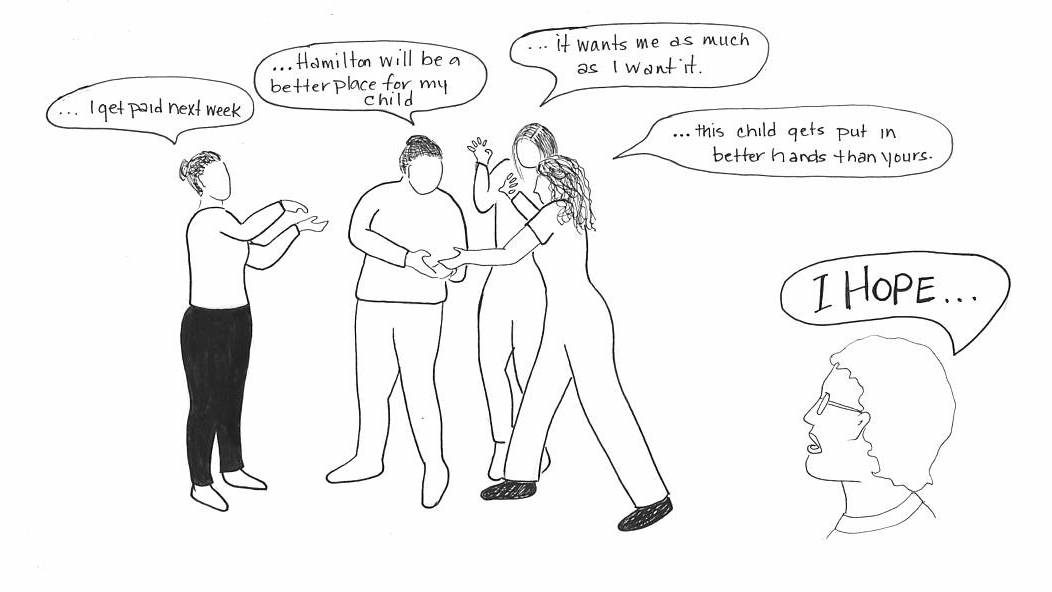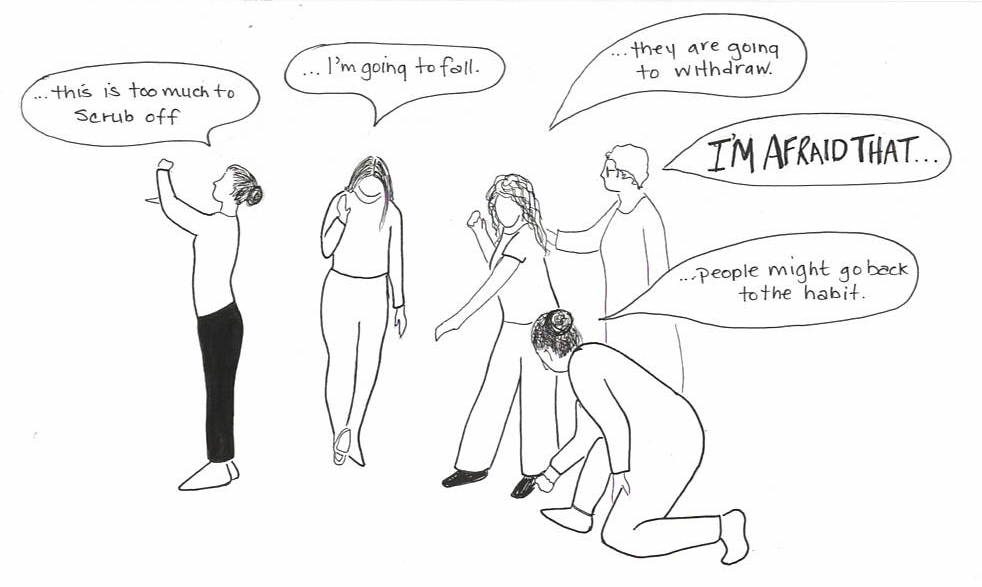Image Theatre
“One of the reasons that we really focus on the silence piece during Image Theatre exercises is that we don’t want the stories to develop too soon and we don’t want it to be any one person’s story. We’re really trying to build a collective vocabulary of telling stories through your body. The stories can be verbalized later. Often, when we explain how the exercise is going to work, we tell participants, ‘We’re going to talk a lot about this, just not right now.’”
— J. Adam Perry, TSDC research and workshop team member, School of the Arts.
Developed by Brazilian theatre maker Augusto Boal, Image Theatre can be thought of as a theatrical application of the adage, “A picture is worth a thousand words.” The basic idea is that working in silence, participants use their bodies to create an ‘image’ or a frozen sculpture. (For full description of the technique see Augusto Boal’s book The Rainbow of Desire.)
In TSDC performance creation workshops Image Theatre is used as a live storyboarding technique, where a collective story is developed through a series of still images. Participants create images, or group tableaus, in response to prompts that are designed to focus their imaginations. These embodied images are then developed through the use of prompts that elicit words and dialogue from within the images and by having participants physically transition between images.
Image Theatre is an excellent resource for working with non-actors to develop a public performance because it:
- Requires no prior acting experience.
- Gives participants an immediate and embodied experience of how theatrical images can communicate a complex range of meanings.
- Helps non-actors build performance skills.
- Allows for multiple, even conflicting, expressions within a single image.
- Generates material that can be used in the creation of the performance’s story arc (more on this when we get to Creating the Performance Script).
A TSDC workshop’s first images
Since Image Theatre is the key devising technique used in TSDC performance creation workshops it’s important to introduce it early in order to give participants the maximum opportunity to develop a sense of comfort and agency with the method. The first two images that participants are invited to create are usually done in the second workshop in the series, after the initial story circle workshop.
As always, when introducing a new (and perhaps somewhat strange) workshop activity to non-actors we find it helpful to use familiar non-theatrical language. For example, here’s how we introduced the idea of Image Theatre in a workshop series TSDC did with a group of youth living in precarious conditions in Hamilton: “Think of it like a postcard that you would send your friends to show them what a great place this is for people like you.”

The first image TSDC workshop participants are invited to create is of what a better future Hamilton would look like for people with experiences similar to theirs. As with the story circle prompt, beginning with a future-oriented image prompt is important because it invites participants to shift their focus from what has or is happening to what they want. The better future Hamilton image is then followed by a second image that focuses on what life is like now.

TSDC first images exercise
After providing the first image prompt and introducing the postcard-like concept of Image Theatre, the facilitator explains how the exercise works:
- Tell participants that the exercise should be done in silence, while assuring them, We’re going to talk a lot about this, just not right now.”
- One person starts the image by entering the ‘playing space,’ taking a position, and freezing.
- One at a time, each additional person adds themselves to the image by creating their own gestural response and freezing.
- Once all participants have inserted themselves into the image, explain that you will place your hand on each person’s shoulder one at a time and ask each of them to complete a phrase that you will speak out loud.
- Two sample phrase prompts for the better future Hamilton image are: “It’s much better than it used to be because …”, and; “What I really like about this place is ….”
- After everyone has had a chance to be the first person to start a new group image of what a better future Hamilton might look like, the facilitator shifts the focus to the present with a second image prompt: “Now that you’ve seen the future, everyone at the same time create an instantaneous group image of what life is like now.”
- Repeat the process until everyone has initiated both a better future Hamilton image and what life is like now image.
Bringing the images to life
Once the group has created their better future Hamilton and what life is like now images, the images can be brought to life and further developed. One method for doing this is to have participants transition between the images.
Transitioning between images exercise
- Begin by reviewing documentation of all the images and ask the group to select a better future Hamilton image and a what life is like now image they’d like to start with.
- Have the group recreate their selected better future Hamilton image. Ask them to remember their posture and their relationship to others in the image and then to step out of the image one at a time to see what they created.
- Then have them recreate their selected what life is like now image.
- Tell everyone that you are going to have them transition in slow motion from this what life is like now to their better future Hamilton image by making one movement and freezing each time you clap.
- Let them know that you will clap 4 times, and after the final clap they should be in back in position for their better future Hamilton image.
- After each clap place your hand on each participants’ shoulder and have them complete a phrase. Phrase-prompts can include, “I hope…” “I wish that…” “I’m afraid that…”
Group reflection
After Image Theatre sessions it’s important to give participants an opportunity to reflect on the images they’ve created. This can be done by asking participants things they noticed about the positive (better future Hamilton) and the negative (how things are now) images they collectively created.
The collective reflection process:
- Allows participants to articulate what was meaningful for them about the images.
- Makes visible the differences in worldviews that are present in the group.
- Builds participants’ sense of agency with embodied story telling.
- Provides facilitators with valuable information about the kinds of explorations that might be important to integrate in upcoming workshops.
- Helps in the identification of themes and narrative threads for the development of a performance script.
Creative tension as the ground for story development
As with the story circles, the prompts for the first two images that participants are invited to make are introduced in the first phase of the workshop series, which is focused on getting to know one another and getting to know the work. The prompts for these first two images remain fairly consistent in all TSDC performance creation workshops: 1) What a better future Hamilton would look like for people with experiences similar to theirs, and 2) how things are now. Taken together these two prompts are designed to tap into what this particular group of people desires for themselves in the world and to begin a collective embodied exploration of the social obstacles that get in the way of those visions.
The first two images establish a creative tension between participants’ vision of a better future Hamilton and what life is like now for people with experiences like theirs. When participants transition between the images they embark on an active and embodied exploration of this tension. The process is slowed down and elaborated by asking participants to freeze at four points on their transition as they move from one image to the next and respond to the phrase prompts that are introduced by the facilitator.

This slowing down provides participants with multiple opportunities to both make choices (what to do next, and next, and next…) and to articulate (by responding to the phrase prompts) their experience from the point of view of their shifting position(s) in between the images.

The prompts and their embodied expression through the images provide participants with some grounding not only in the methods that will be used throughout the workshop series, but also in the kind of dramatic narrative they are working to collectively create: A story that focuses audience attention on their collective vision for a better Hamilton while also exposing what and how they (and people with experiences similar to theirs) experience the present day social conditions that persistently impede their desires.
Moments of change and choice-making
As participants are asked to transform an image either by transitioning between images (as described above), or through other Image Theatre improvisation activities, they always have choices to make. During these exercises the facilitator pays close attention. In particular, the facilitator watches for moments when people pivot. Sometimes this is quite literal. Their balance changes. They change directions. Sometimes shifts become visible through what participants say in response to prompts or to one another during an Image Theatre improvisation exercise. What are the moments when people gesture or move toward another situation? What are the moments that make somebody shift from feeling alone and isolated in their own problems, to thinking, this is a shared problem, we need to work together?
The facilitator may not recognize moments of change as they occur. Or, if they do recognize a pivot point, its significance to the emerging narrative may not be immediately apparent. This is especially true in the first phase of the workshop series. During this time, the primary focus is for the group to meet one another and to become familiar with the kinds of activities and exercises they’ll be taking part in. As the workshop series progresses, exercises are repeated, more stories and patterns emerge, and with them, pivotal moments become clearer.
Repetition, representation & public speech
One of the ways public speech comes to be public is through the process of how things are taken up — or not taken up. In this sense, TSDC workshops can be looked at as a microcosm of a larger public. During workshops, themes that get repeated and picked up by the group, either physically during the Image Theatre exercises or in group reflections, shift from being individual narratives to becoming adopted as part of the group’s public speech. Our intention (or hope) is that the story these community and self-advocates tell about the City will prompt the audience to consider their own roles in that story. When (or if) audiences take up the story in this way, the story and the issues it addresses extends beyond the public domain of the performer-advocates to become part of a larger shared public.
The downside of this process of ideas making their way into a group’s (or a City’s) public speech is that just as some important things get taken up, other important things can get dropped. This is why, as participants create images and engage in discussions, facilitators need to pay attention not only to what gets taken up by the group. They also need to be aware of moments where something may be trying to get articulated that has to do with an identity or an experience that is either a minority voice or isn’t well represented in the room. Again, working closely with community support worker can help ensure that there will be a diversity of standpoints and perspectives in the workshops and assist facilitators in picking up on missed cues.
It’s also crucial in the workshops to cultivate an attitude of collective responsibility for addressing issues of marginalization so that responsibility doesn’t land on the shoulders of individual participants. TSDC’s focus on creating a collective story is one of the ways we cultivate this attitude. TSDC’s collective storytelling approach signals to participants that they aren’t limited, or expected, to focus on telling ‘their own’ stories. Instead they’re being asked and supported to tell stories that focus on the broader social values that they want to communicate or contest. This collective storytelling framework creates opportunities for the group to address issues they’re aware of, even if they don’t belong to a population that’s directly impacted or targeted by a particular form of oppression.
For example, all of the youth we worked with on the play Choose Your Destination had experience with issues related to seeking shelter and housing. They also expressed, however, interest in depicting a broader range of issues than those they had personally experienced. As TSDC research assistant and member of the Choose Your Destination workshop team Sarah Adjekum writes:
“The conversations that emerged [in the workshops] were ones that touched on the difficulties of being queer or trans while homeless. They captured the difficulties of seeking shelter and couch surfing while being exposed to prejudice and at times violence. The youth demonstrated that while they had not walked in the shoes of their peers, they had a window into some of the difficulties that face LGBTQ youth.” — Sarah Adjekum, TSDC research assistant and member of the Choose Your Destination workshop team.
Since none of the cast identified as queer or trans, the challenge then became how could we appropriately include stories of gender diversity and sexual orientation? Using offstage characters and conversations between onstage characters is one method we’ve used to integrate issues into TSDC plays without individual performer-advocates having to play characters that are part of the targeted or marginalized population. This scene description is an example of how we did this around the issue of queer youth and housing in Choose Your Destination:
‘Joanne’ answers a phone call from her friend. Her friend’s parents have kicked her out of their house for coming out as a lesbian. Joanne promises to try and find her friend a place to stay for the night and calls her roommates asking if she can stay at their house. Her roommates tell her ‘no’ and make homophobic remarks. Joanne gets angry at their homophobia and hangs up the phone.
Facilitators also need to pay attention to things that don’t get expressed at all. Sometimes, when people are in a minority position in the group, they may refrain from speaking out for a number of reasons — self-protection, resistance, discomfort or uncertainty about how others will respond, or frustration with having to educate others.
If the facilitator thinks someone may be choosing not to speak up about something that they want to see addressed in the play, it’s important to offer support while being careful not to put them on the spot. One approach is for either the facilitator or the community support worker to take the participant aside or call them up later. We might say something like, “I’m thinking about how homophobia (or racism, or ableism…) might be at play in these kinds of situations. Is that something you’d want to highlight in this scene, or would you prefer not to go down that path at this time?” Since theatre is a physical and live medium, we need to be especially careful to make sure individuals don’t feel pressured to publicly ‘represent’ an identity group that is different from the other performers.
Documentation, process, and script development
Documentation is a critical tool during the performance creation process! Documentation allows participants to see what they’ve created and to recall the words and phrases that were generated during the exercises and the collective meaning-making reflections. Digital photos that can be readily accessed are extremely helpful as visual prompts when participants are recreating images. Documented images and text can also be compiled into a PowerPoint presentation to be shared during the next session. Or, if there happens to be a sketch artist on the team, simple drawings of the images could be made. In addition to refreshing everyone’s memory, this method provides participants who missed a session with a quick way to see what took place.
Video documentation is also important for both workshop planning and script development. In tandem with the workshop debrief session with the project’s community support worker, documentation provides the workshop facilitator with a means of reviewing and reflecting on what took place during the workshop. This helps them as they consider what activities and prompts would be the most useful for the next workshop.
In terms of scene and script development, video documentation is absolutely crucial! Even the keenest of theatre facilitators will miss things like pivot points and story themes that emerge. As the material that the group generates though the workshops accumulates video documentation allows the facilitator to revisit previous sessions. Through this process of review and reflection, they can begin to recognize important moments and connections that may not have been apparent in the moment.
It’s helpful to think of Image Theatre as a kind of ‘live storyboarding’ where embodied images can be seen as snapshots of more developed scenes. Key phrases that emerge when the images are brought to life through the combination of transitions and phrase prompts, as well as through group-generated scene titles, can be added to the documented still image. These images then can act as cue cards (kind of like movable comic strip panels) that the creative team and participants can arrange, rearrange, and add to, as they work together to construct a skeleton script (more on this in TSDC Scripts: Why & How).
Things to keep in mind:
- Show don’t tell! Remember that as a facilitator, introducing the exercise is an opportunity to performatively model what you are asking participants to do and helps minimize the amount of time spent explaining the exercise while also demystifying the exercise.
- Remind participants to remain silent throughout the image building exercise. Since, for most participants, talking will be a more familiar method of communicating than physical creative exploration, you will likely have to reinforce this idea throughout the workshop series.
- Remind participants that when they are completing a phrase or taking part in an image, they are not speaking or acting ‘as themselves,’ but from their position, or character, in the image.
- Pay attention to the choices or decisions participants make as they transition between images and to how those choices shift the collective image.
- Be sure to document the Image Theatre explorations, participant phrases, and group discussions.
a panel or panels on which a sequence of sketches depict the significant changes of action and scene… (Dictionary.com)

